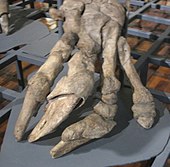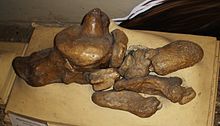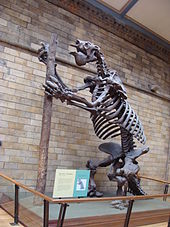Megatherium
Megatherium is a genus of the extinct family Megatheriidae, a group of sometimes giant sloths. In particular, the elephant-sized M. americanum is one of the best known and best studied forms and, along with Eremotherium, represents the largest known representative of the large ground sloths. The genus occurred from the early Pliocene about 5 million years ago until the transition from the Upper Pleistocene to the Lower Holocene about 8,000, possibly only until about 11,000 years ago. Within the genus, two developmental lineages can be distinguished. One is the lowland form M. americanum, which inhabited the central to partly southern areas of South America under temperate climatic influence, mainly the Pampa region in present-day Argentina, the other occurred mainly in the high mountain areas of the Andes and included several species. Both evolutionary lineages can be distinguished by features on the skeleton.
As an extensive herbivore, Megatherium fed mainly on soft plant food. To feed, it was able to rise up on its hind legs, with the powerful tail serving as a support on the ground. The massive arms were used to pull branches and twigs. In some cases, however, a much meatier diet is also discussed. Also at the center of scientific debate is the question of whether Megatherium not only reared up for feeding purposes, but was also capable of sustained bipedal locomotion, in which case it would be the largest known mammal with such a mode of locomotion. Both the view of a predatory lifestyle and of a permanent bipedal gait are highly controversial.
The discovery of fossil remains of Megatherium dates back to the late 18th century. A skeleton from Luján in present-day Argentina led to the first scientific description of the genus by Georges Cuvier in 1796. Further significant finds were collected in 1832 by Charles Darwin on his historic voyage with HMS Beagle around South America in the pampas regions. Megatherium played a significant role in the development and establishment of paleontology as a branch of science during the 19th century. The early research history of the genus is not only marked by numerous new discoveries, but also by individual crucial errors.
Features
Height
Megatherium comprises medium-sized to very large representatives of the ground sloths. The smallest species, M. altiplanicum, is estimated to have weighed between 1.0 and 1.7 t, while M. americanum, the largest representative, probably reached a body weight of 3.8 to 6.0 t with a total length of 6 m and a shoulder height of 2 m (based on various determination methods). Thus, Megatherium possessed similar dimensions to the related and roughly contemporaneous Eremotherium. The variability of size within the genus is indicated, among other things, by the characteristic femur. M. altiplanicum had a length of 39 cm, M. urbinai, M. sundti and M. tarijense represent medium-sized species with femora of 46 to 53 cm, while at the upper end of the size spectrum the femur of M. americanum was between 57 and 78 cm long. This makes Megatherium one of the largest known sloths, along with Eremotherium. In general, Megatherium was not quite as robustly built as its relative Eremotherium and had comparatively shorter limbs but a longer skull. As with all ground sloths, however, arms and legs were significantly shorter relative to body length than in modern tree sloths. Furthermore, analogous to other ground-dwelling sloths, Megatherium possessed a strong, long tail.
Skull and dentition characteristics
The skull of the large species became 72 to 87 cm long, reaching a width of 36 to 46 cm at the zygomatic arches, and 27 to 31 cm at the occiput. Altogether it was tubularly elongated and narrow in plan view. The frontal line showed a prominent sinusoidally curved to slightly domed profile in lateral view. The paired metacarpal had a Y- or X- to rectangular shape, with the two bones firmly fused together, as well as a firm fusion with the maxilla. However, in some smaller species the fusion was not very strong, so that the middle jaw bone is sometimes found separate from the skull, or is sometimes unknown. The upper jaw was very high to contain the extremely high-crowned teeth. A characteristic feature was the zygomatic arches, which were particularly massive and, in contrast to today's tree sloths and numerous fossil forms, were fully developed, so that the two bases of the zygomatic and temporal arches touched each other. Furthermore, there was a strong, downward bone outgrowth at the anterior zygomatic arch attachment, which served as a muscle attachment site. The parietal bone had a strong parietal crest, which divided in front and led over the temporal bone as a sharp line in each case. The occipital bone had a rectangular shape in lateral view. Especially in the smaller species from the Andean region, the articular insertions for the cervical spine were strongly extended backwards and thus very prominent.
The mandible showed a massive construction and measured between 62 and 74 cm in length in large species. The symphysis was also strong, relatively flat and, as in most sloths, completely fused. It ended at the level of the first or second molar. Anteriorly it was distinctly elongated, thus forming a narrow bony outgrowth, the length of which exceeded that of the entire row of teeth in some cases. Very conspicuous was the downward curved margin of the mandible, typical of megatherms. Here the bone body partly reached up to 25 cm height, which is the highest value for all Megatheria, but in Megatherium the bulge is also most obvious compared to the size of the mandible. The alveoli of the mandibular teeth were located in the bulge. Furthermore, the articular branches protruded very far upwards. The dentition consisted of five teeth per maxillary and four per mandibular half, analogous to all megatherians, so that a total of 18 teeth were formed. The teeth were homodont and molar-like, of square shape and had two transverse ridges (bilophodont) on the occlusal surface. Typically, the teeth had no enamel and stood closed in a row. The length of the lower row of teeth varied and was between 18.6 and 25.9 cm in the large M. americanum, between 15.2 and 20.4 cm in medium-sized forms such as M. tarijense or between 13.0 and 17.2 cm in M. medinae, and 14.4 cm in the small M. altiplanicum.
Body skeleton
The body skeleton is largely known due to numerous finds. The spine included 7 cervical, 16 thoracic, 3 lumbar, 3 sacral, and 17 to 18 caudal vertebrae. Unlike Eremotherium, the three articular surfaces connecting the cervical vertebrae atlas and axis were not fused together in Megatherium. The limbs were generally shorter on average in Megatherium than in Eremotherium. The humerus existed as a tubular bone up to 80 cm in length, with the lower joint bulging out to a width of 37 cm. In general, the humerus of megatherians was shown to be longer, more gracile, and flatter than in other ground sloths. At 69 cm long, the ulna possessed a long and slender structure with laterally narrowed joint ends. The upper end of the joint, the olecranon, could be elongate and narrow in shape in most smaller species, but was broad and bulky in the largest. The femur, as in all megatherians, presented a broad and massive bone, but with severe narrowing in front and behind, so that the width of the bone exceeded its depth by a factor of four. The longest known bone was 78 cm long and a good 42 cm wide, the smallest only 39 cm long and 20 cm wide. In places the shaft was clearly twisted. The third trochanter as a muscle attachment point on the shaft, which is characteristic of secondary articulated animals, was missing as in all megatherians. The articular surfaces protruded distinctly, so that the bone did not appear as rectangular in overall view as in Eremotherium. The tibia and fibula were fused together at both ends, rather than only at one as in the related Eremotherium. The length of the tibia was about 54 cm.
The hand was basically four-rayed (rays II to V) and thus deviated from its close relative Eremotherium with a three-rayed hand (in late representatives). As in Eremotherium, however, the metacarpal bones of the two outer rays were the most developed in Megatherium, reaching lengths of 25 and 23 cm, respectively. They clearly surpassed the two inner rays. The metacarpal bone of the first ray and individual carpal bones such as the large polygonal bone were fused to form the so-called metacarpal-carpal complex (MCC) (in Eremotherium additionally the second metacarpus). In total, only the second, third and fourth fingers had three phalanges each, but on the third the two rearmost phalanges were fused into one unit. The respective terminal phalanges bore claws and usually had a triangular shape in cross-section. Due to the massive formation of the last phalanx on the third ray, the largest claw was probably originally formed here. On the fifth finger there were only two phalanges, the terminal phalanx was missing. The foot had three rays analogous to that of the other megatherians (rays III to V), whereby the metatarsal bone on the third ray was clearly shorter. This was also the only toe ray that included three phalanges-but as in the hand, the first two limbs were fused together-and thus bore a claw. The two other, outer rays had only two phalanges, greatly reduced in length, and consequently had no claws formed.

Megatherium skull

Left forefoot of Megatherium with the typical four rays

Right hind foot of Megatherium with the typical three rays
Distribution and important fossil finds
Megatherium was widespread from the Pliocene to the early Holocene mainly in the central and partly southern region of South America, only in the high mountain ranges of the Andes it penetrated further north. Finds are mainly known from Argentina, Uruguay, Chile, Bolivia, Peru and Ecuador. The more northerly and tropical lowland regions, on the other hand, were inhabited by the closely related genus Eremotherium, which, in contrast to Megatherium, also reached North America. One of the few common occurrences of the two giant ground sloths has been found in the middle to upper Pleistocene Santa Vitória Formation on the banks of the Arroio Chuí and other rivers in the Brazilian state of Rio Grande doSul. Megatherium survives here with a partial skull and individual elements of the body skeleton. The majority of the finds, however, come from the Pampa region in Argentina and, in the opinion of many researchers, they all belong to the very large species M. americanum, which, according to this opinion, was also the only representative in the lowlands east of the Andes. Among others, Punta Alta near Bahía Blanca in the province of Buenos Aires, where Charles Darwin already collected finds during his voyage with the HMSBeagle in 1832, or Luján, one of the fossil-richest sites in Argentina in the same province, where the skeleton came from that served Georges Cuvier for the first description of Megatherium. Representative of the numerous other finds in the Pampas is the almost complete lower jaw of M. americanum from La Chumbiada on the Río Salado in the north of the province of Buenos Aires, which is about 12,000 years old and was found associated with the predatory cat Smilodon and the horse Hippidion. Overall, M. americanum represents not only the largest representative of Megatherium, but also the most documented and best studied. However, isolated finds of smaller forms such as M. filholi are also known from the pampas, so that the genus Megatherium probably had a more complex distribution history in the region. The sites Rocas Negras near Mar del Sur in the south and Carmen de Areco as well as several other sites in the north of the province of Buenos Aires are worth mentioning.
Otherwise, mostly smaller species of Megatherium have been described from the Andes. As a rule, however, only very little material has been found of them and they obviously occurred less frequently than their larger relative in the Pampa lowlands. As a result, these species are usually less well studied, so that, for example, hardly any statements can be made about intraspecific variability. M. medinae is known from Chile, a medium-sized and graceful form that was described using a dentition remnant and single hind leg bones from the Pampa del Tamarugal. Other finds, such as a mandible, vertebrae, and ribs, come from near Santiago de Chile. The smallest and oldest species is M. altiplanicum, which is attested via some skull remains and postcranial skeletal elements from the Lower Pliocene Umala Formation near Ayo Ayo in the department of La Paz in western Bolivia. In geographical proximity, also in the northern part of the Altiplano, the medium-sized species M. sundti has been found in the Ulloma Formation of the early Middle Pleistocene near Ulloma on the Río Desaguadero. Its finds include two skulls, one with a mandible, which were used to describe the species in 1893, and a partial skeleton of an immature individual. From the Tarija Formation near Tarija in southern Bolivia, on the other hand, comes the roughly similarly sized M. tarijense in the form of a complete skeleton, which was already recovered in the 1920s. A partial skeleton from Yuntac in Peru can also be assigned to the same species. Located at 4500 m above sea level, this is one of the highest finds of Megatherium. A femur has also survived from the Cuzco Valley. An incomplete skeleton from Santa Rosa Cave near Celendin in the Peruvian province of Cajamarca served to describe M. celendinense, the largest representative of the Andean species to date, which was almost as large as M. americanum itself. M. urbinai, on the other hand, was considerably smaller and very graceful. A partial skeleton of it has been recovered from Sacaco in the coastal region of southwestern Peru, and another from Tres Vantanas Cave 70 km southeast of Lima at an altitude of about 4000 m. A third skeleton - a juvenile, located in aeolian sediments near Uyujalla also in the coastal area - was also reported, but this was lost before recovery. A partial skeleton of M. elenense was found at La Brea near Talara in northwestern coastal Peru, as well as at Cerro de Pasco in the Pasco region at 4300 m elevation. This smaller representative of Megatherium was first introduced by Robert Hoffstetter in 1952 on the basis of some finds from the Santa Elena Peninsula in Ecuador, but under the generic name Eremotherium. The type material of Eremotherium, which had been described by Franz Spillmann in 1948, also originated from the same peninsula.

Skeleton reconstruction of M. americanum in the Natural History Museum of London
Search within the encyclopedia